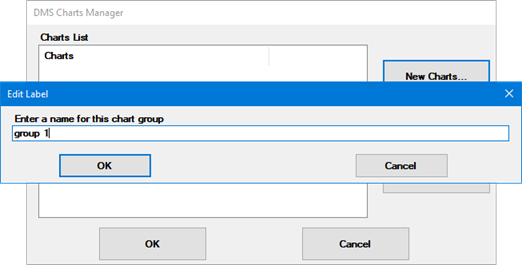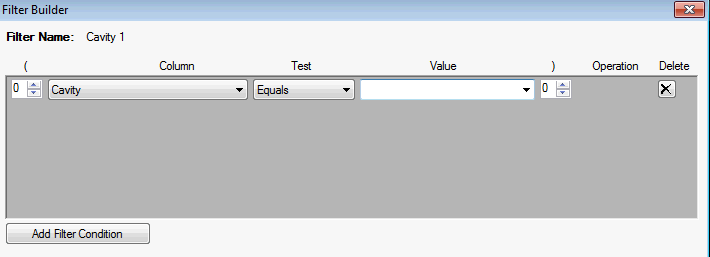
The DMS Chart Options window lets you configure charts to display on the current sub-inspection. For information on opening this window, see Setting charts to display in inspections.
|
Contents [Hide] |
When you first click New to create a group of one or more charts, you are prompted to name that group.

When editing the chart group, you can change this name.
If you want this sub-inspection to chart multiple standards with the same chart types and chart settings (date period, filter, statistical settings, etc.), you can use this step to select all those standards at once – beginning with the Part Number Source:
Select standard from list:
This creates static charts for any standards or processes you choose – regardless of any DMS Standard tests in the inspection, and regardless of the Process property of the inspection. These charts will not be updated when new data is entered on this inspection, unless the inspector right-clicks the chart to refresh or it is refreshed by a Python script.
For help selecting standards, see Selecting Part Numbers or Processes.
This creates dynamic charts that are linked to the Process property of the inspection. These charts will be automatically updated when new data is entered on this inspection. Any of these charts will also be automatically updated if the part number, process, filter name, or filter contents change, and it will be removed (charts from the left-hand list) or updated (charts from the right-hand list) if any of this information is cleared. For more details, see Chart behavior during data entry.
Use Inspection Part Number and Process:
This creates dynamic charts that are linked to the standard specified in the current DMS Standard test for this sub-inspection. These charts will be automatically updated when new data is entered on this inspection. Any of these charts will also be automatically updated if the part number, process, filter name, or filter contents change, and it will be removed (charts from the left-hand list) or updated (charts from the right-hand list) if any of this information is cleared. For more details, see Chart behavior during data entry.
When finished selecting standards, click Next Step.

For this chart group, the Draw all charts in one panel check box sets whether to display each chart on a separate side panel tab or combine all of the charts on one side panel tab.
Clearing the Draw all charts in one panel check box displays each chart on its own tab, like this:

If two chart groups with this setting draw the same chart type for the same information (Process, Part Number, Filter, and Date Period), only one side panel tab will be created.
Selecting the Draw all charts in one panel check box combines all of the charts on one tab, like this:

When combining multiple charts on one tab:
Displaying more than 16 charts on one tab is not recommended; it can greatly slow down performance when refreshing the charts or resizing the side panel.
The tab name is set to the chart group name.
If the chart fonts are too small, choose a chart skin with larger font sizes on Step 3.
A chart group with this setting always creates a side panel tab - even when another chart group draws the same chart type for the same information (Process, Part Number, Filter, and Date Period).
Select the DMS chart types you want to display, and then click Next Step.


Choose retrieval and statistical settings for the standards and charts you have selected. You can also specify a Chart skin (created in the GainSeeker Charts module) that changes display options for these charts. When finished, click Save and Close.
 Note: If you display a Statistics
List or Statistics Table, GainSeeker will use the default report name
from the current Chart skin (if specified) or from the current GainSeeker
configuration. If a default Statistics list or Statistics table report
name is not specified in either of these areas, GainSeeker will simply
display system default statistics on these charts.
Note: If you display a Statistics
List or Statistics Table, GainSeeker will use the default report name
from the current Chart skin (if specified) or from the current GainSeeker
configuration. If a default Statistics list or Statistics table report
name is not specified in either of these areas, GainSeeker will simply
display system default statistics on these charts.
 Tip: If desired, you can configure
the charts with a special filter for data that matches traceability values
in this inspection, as described below:
Tip: If desired, you can configure
the charts with a special filter for data that matches traceability values
in this inspection, as described below:
In some cases, you may wish to filter the chart for a traceability value that was entered in this inspection – by a Traceability test in a previous sub-inspection or the current sub-inspection, a Planned Inspection, or a Formula test.
For example, you might wish to filter for:
a Lot number that the user enters during data entry
a Machine ID that you preset with a Planned Inspection or Formula test
To filter for such a traceability value – which may vary from one data entry session to the next – you must create a Quick filter or a saved filter that looks for a blank value in that traceability field, such as this example which filters for the current Cavity number:

If this traceability value is not set before the sub-inspection with the filter is opened, the charts that use this filter will not be drawn until a value has been set for this traceability field. If this traceability value is cleared, the charts that use this filter will be removed.
A chart will open when the sub-inspection opens and all information necessary to open the chart (Process, Part Number, and Filter contents) has been defined.
Any chart linked to the Inspection Process or Part number and Process will be refreshed (the chart's data is re-retrieved from the database and statistics are recalculated) when there is a change to any of the information for the chart (Process, Part Number, and/or Filter contents). Changing any traceability values that will be stored with the linked tests will also cause the charts to refresh. These changes can be triggered by the sub-inspection that created the chart or by a later sub-inspection that changes any of these values.
Submitting data for any linked chart will refresh that chart.
If two chart groups draw the same chart type for the same information (Process, Part Number, Filter, and Date Period), only one side panel tab will be used.
Side panel charts will be closed when any of the information for the chart is removed, when the side panel is cleared, or when the inspection is closed.
The inspector can interact with the chart by clicking or right-clicking on the chart's background or graphics.